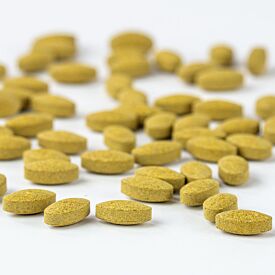Spring for Pitta-Kapha & Kapha-Pitta

As a pitta-kapha or kapha-pitta type, spring is a season to offer kapha some deep and intentional support. That said, there’s no harm in being mindful of the benefits that spring’s heavy, gentle, and cool qualities offer pitta’s light, sharp, and hot nature.
As the season progresses and the weather warms, do your best to protect yourself from accumulating any excess heat. And feel free to adapt your routine as your local climate and your internal state of balance change.
The following modifications to a typical springtime routine are designed specifically to support your constitution. If you are not familiar with the basic tenets of a traditional springtime routine, you might benefit from first reading Banyan's more general Ayurvedic Guide to Spring.
You may also find it helpful to read both the kapha and pitta recommendations for suggestions on how to support each of your primary doshas independently.
Foods to Favor
Most pitta-kapha types and kapha-pitta types do fine to eat a fairly straightforward kapha-pacifying spring diet with a peripheral awareness around protecting pitta. The bitter and astringent tastes are especially good for both kapha and pitta.
- Favor foods like apples, berries, pears, pomegranate, raisins, soaked prunes, artichokes, asparagus, bell peppers, beets, broccoli, brussels sprouts, cabbage, cooked carrots, cauliflower, celery, greens (such as kale, collards, dandelion, or beet greens).
- Include green beans, leeks, lettuce, mushrooms, cooked onions, peas, white potatoes, rutabaga, raw spinach, and sprouts.
- Opt for amaranth, barley, dry oats, quinoa, basmati rice, rice cakes, tapioca, most legumes, cottage cheese, goat’s milk.
- Enjoy small amounts of fresh yogurt, popcorn, pumpkin seeds, sunflower seeds, egg whites, freshwater fish, shrimp, venison, ghee, and sunflower oil.
Acceptable Seasonal Indulgences
Early in the spring, you will likely tolerate some especially light or heating foods: a spicy meal or some caffeinated tea—perhaps green or black tea with a little honey. And on especially damp and heavy days, you might even get away with enjoying a cup of coffee or espresso.
While you will want to be diligent about limiting sugary sweets and snacks for kapha’s sake, deliciously light, fruit-based treats such as baked apples, delectable prune bars, or a fruit crumble are all appropriate springtime indulgences.
Foods to Minimize
- You may need to minimize your intake of bananas, grapes, grapefruit, kiwi, rhubarb, tamarind, olives, molasses, brown rice, urad dal, and store-bought yogurt (homemade is fine).
- Reduce beef, dark chicken or turkey, duck, egg yolks, saltwater fish, pork, most nuts, sesame seeds, almond oil, peanut oil, safflower oil, and sesame oil.
- If pitta starts to get aggravated, limit especially hot spices like cayenne, chilies, and dry ginger.
- Beyond that, watch for signs of increasing kapha (heaviness, lethargy, brain fog) or increasing pitta (acidity, irritability), and adapt your diet accordingly.
Lifestyle Adjustments
As a pitta-kapha or kapha-pitta type, it’s important to balance the focus and stimulation that benefits kapha with the relaxed sense of surrender that soothes pitta. While the season’s soft, heavy, and nurturing qualities can be calming to pitta, springtime is also teeming with energy and it’s important not to push too hard.
The general spring guide lifestyle recommendations are typically fine for pitta-kapha and kapha-pitta types, as long as you are aware of the few practices that are potentially aggravating to pitta. Here are a few tips that may help you stay balanced.
Adjust your self-massage oil.
Using Sesame Oil for your abhyanga, or self-massage with warm oil, might be fine for you in the early spring while the weather remains cool, but consider cutting your sesame oil with Sunflower Oil as the spring heats up (perhaps eventually switching to sunflower oil entirely). And if your skin is especially sensitive or prone to excess heat, you may want to avoid sesame oil from the outset.
Another option is to use an herbal oil like Kapha Massage Oil in the cooler weather, then switch to Pitta Massage Oil once the weather is warmer.
Assess whether drying, warming practices are right for you.
Gauge the appropriateness of practices like an Ayurvedic dry massage (or garshana), herbal powder massage, or sauna according to the local climate, your current state of balance, and your own tolerance for heat. While the light, dry, and warming qualities of these practices are great for kapha, they can be too heating for pitta.
Enjoy exercise without overheating.
Spring is a good time to honor your inner athlete, but do so with a light heart and, again, be careful not to overheat. For yoga, incorporate plenty of standing poses, twists, and forward bends.
Learn more about how to tailor your exercise for your doshas.
Tend to your sleep.
This is a time of year when you might get away with retiring later at night. But if you find that you are too preoccupied—or too amped up—to sleep, try retiring around 10 p.m., or even a bit earlier. To help wind down and let go of the day, try a relaxing bedtime routine to calm and soothe pitta.








